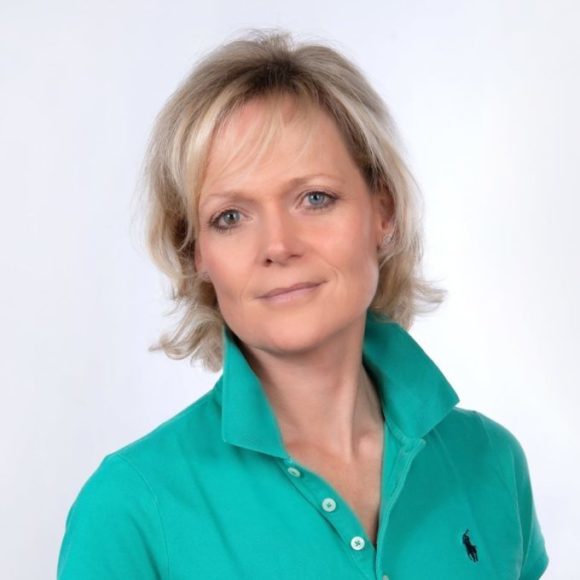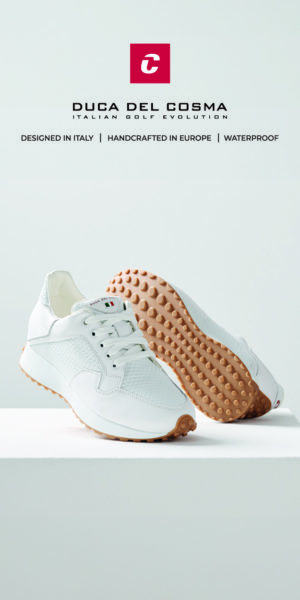Posted on August 5, 2020 in News.
Kristel Mourgue d'Algue: "The distance between the balls should be reduced by around 25% for the pros"
Former player of the European circuit, Kristel Mourgue d'Algue is part of a family that counts in French golf, her parents having notably been at the origin of the Lancôme Trophy. She is now co-owner of the Grand Saint Emilionnais Golf Club and regularly writes columns in which she gives an informed opinion on our favorite sport. Interview.
Hello Kristel, after a career on the European circuit, you are now a correspondent for Golf Magazine USA, golf ambassador for Beachcomber hotels and co-owner of the Grand Saint-Emilionnais Golf Club. How has your golf been impacted by the current crisis?
It didn't go too badly for us. We have about ten gardeners and we took advantage of the confinement to work, treat and clean the course, which is in very good condition. We have more and more members and golfers who come to discover or replay our course. Obviously, we have hardly any tourists this summer, but this is compensated by the French players who come, even more than usual, to tread our fairways.
The Grand Saint-Emilionnais is a young course that opened in 2015 and has already been ranked 5e French golf by Golf digest. Why do you think it enjoys such a good reputation, what are its strengths?
It is the first course in continental Europe designed by Tom Doak, who is considered one of the three best architects in the world. In Scotland it was he who designed the Renaissance, near Muirfield, and host last year of the Scottish Open, the one where Benjamin Hébert lost in the play-off. Tom Doak's trademark is that he is keen to preserve the natural site, it is the “routing”, the sequence of holes that blend completely into the landscape. He used 67 of the 102 hectares that were at his disposal to design the course. The setting is magnificent, you play among vines and hundred-year-old oaks ... The natural hilly area is full of charm and adds to the pleasure of the game, including in terms of technical challenges because you don't always have your feet flat.
It also seems that we can see the tower of the castle of Montaigne?
Yes, we can see it when leaving the green of 5, but also from the parking lot of the clubhouse. We can also see a Romanesque church from the XNUMXthe century located in our town of Gardegan-et-Tourtirac. The architect has cleared the trees from the green of 16 so that we can see it.
In your columns *, you regret that the courses are no longer defending themselves today against the elite of world golf, more and more powerful in driving. What would be your solution to counter this trend?
We should change the ball for the pros, because we no longer play the same game as them! They train eight hours a day, work out, have a nutritionist and a whole staff around them, it has nothing to do with amateur golf, the gap is becoming ridiculous. For the pros, the par is 68 on most courses, they play par 5 in two with irons, sometimes ending the tournament at -25. Suddenly, golf courses are being built longer and longer and which cost a fortune to host championships ... Amateurs take more than 5 hours to play them and spend their time looking for their ball because it is too hard. Instead of embarking on a quest to lengthen courses which are also very greedy in water, the first solution is to reduce the distance of the balls by about 25%. In terms of architecture, we also recently saw at the Memorial that as soon as we have very firm conditions, with fast greens, it becomes much more difficult than when we just play darts with wet greens.
Wouldn't we risk creating two different sports, one for amateurs and one for professionals?
You know, other sports like baseball have different rules for amateurs and pros. Metal bats are allowed for amateurs, but not for professionals. And to come back to golf, amateurs have the right to use a rangefinder, but it is prohibited for professionals in competition.
You also recommend making bunkers more difficult for professionals to play, in particular by stopping raking them ...
Yes. In Pine Valley, New Jersey, that's their philosophy. It's not about no longer raking the bunkers for Sunday golfers, because it would become too hard for them and it would slow down the game. But today, the pros almost prefer to be in the bunker than in the rough, this is not normal. A bunker among the English is first of all an obstacle, a "havoc" (which can also be translated as "damage" or "damage"). On the PGA, they bring in special sand every week so that the grain size is perfect. Today, the bunkers are not penalizing enough, the lie is often perfect. What's interesting is seeing the dexterity of the best players in the world when they have to get out of sticky situations.
In another of your columns **, you mention the very variable age at which champions are forced to rank clubs. At 50, Phil Mickelson enjoys a unique longevity at the highest level and again finished second in a world championship event last Sunday at the St. Jude Invitational. How do you explain it?
Mickelson is first and foremost an exceptional talent. Without Tiger Woods, he would have doubled his record. His secret is also extraordinary flexibility, a bit like Vijay Singh for that matter. And then it is also linked to his swing: like Ben Hogan in his time, he takes off his right foot when climbing, which removes all the tension on the lower back. You have players like Jason Day who have their feet firmly rooted in the ground, as we often learn to do, and who have back problems. Flexibility is a factor in golf longevity. A player like Dustin Johnson, beyond muscle building, requires for example two stretching sessions per day.
Your parents created the magazine European Golf and the Lancôme Trophy. Many enthusiasts regret this tournament, which has had prestigious winners. Why did he stop?
Tiger Woods was supposed to come and play it, but September 11, 2001 did happen and he didn't come, it was kind of the trigger. The course of Saint-Nom-la-Bretèche was not either completely adapted to a field of 140 players and to the reception of many spectators, who came by shuttle from car parks created for the occasion. My father had suggested to Lancôme, which is a cosmetics and luxury goods brand primarily intended for women, to organize instead a Women's Masters with the 70 or 80 best players in the world. But it did not happen.
You were nine times French amateur champion, you won the university championship in the United States and played on the European circuit. What is the best memory of your career?
Undoubtedly the American university championship in 1995. I was one of the first French to go to the United States, there the university is the antechamber of the professional world. There is also my victory at the Philippine Open in 1998, which counted for the European circuit. At the time, we played the first five tournaments of the year in Asia.
And your worst memory?
Playing against my mother in the National Open was a bad feeling. You wish your own family the best, but at the same time you want to win. We are shared, it's a terrible ambivalent feeling ...
Your best score?
65. It seems to me that this is the record for the course for women in Saint-Nom-la-Bretèche, of which my grandfather is a founding member.
Is there a player that you admired during your professional career?
Nancy Lopez. She was the best player in the world and she started a family, she managed to reconcile the two, which is always difficult. I had the opportunity to meet her when I was young and it was a great memory. There is also Annika Sörenstam, for her work capacity and longevity at the highest level. I remember a British Amateur where there was no practice. So she was training on the course until nightfall and was going to collect her own balls. She was calm, thoughtful, she was a very good representative for women's golf.
You edited a few years ago the Rolex guide to the 1000 best golf courses in the world. If you had to choose one in France, which would it be?
What I like above all in golf is the variety of courses, sites, sensations that one can experience. But if I had to choose one in France, I would say Chantilly. It's a golf course that has a history, there is the layout, I won an omnium over there against my friend Patricia Meunier-Lebouc. I also won the French championship there when I was 12 and a half. The director of golf, Rémi Dorbeau, is a former greenkeeper and the maintenance of the course is remarkable.
What do you think is the most common fault among amateurs?
The majority of amateur golfers tend to slicer, to hit from the top as they say. Instead of typing with the lower body, they hit with the arms, which often causes a slice effect. Power comes from the lower body in golf.
Interview by Franck Crudo
* https://swing-feminin.com/chronique-de-kristel-mourgue-dalgue-un-big-bang-indispensable/
**https://us12.campaign-archive.com/?u=1e114592daea23ba517d10a06&id=8d2904f3e8
Louise Uma Landgraf wins brilliantly at the Girls' U16 Amateur Championship
Grace Kim leads the JM Eagle LA Championship
Scottie Scheffler's coronation at the RBC Heritage









